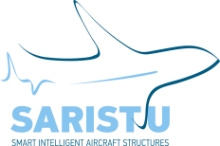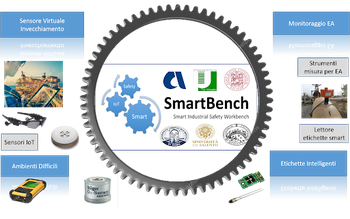Projects
On-going Projects

Guided Waves for Structural Health Monitoring (GW4SHM) - H2020-MSCA-ITN-2019-860104
The GW4SHM project, funded by the Marie Skłodowska-Curie Actions Innovative Training Network (H2020-MSCA-ITN-2019-860104), aims at different aspects of Structural Health Monitoring (SHM) using guided ultrasonic waves. The overall aim of GW4SHM is to turn SHM from a lab-based technology into real-world applications. To overcome current hurdles that prevent the widespread use of SHM, GW4SHM will pursue the following three objectives:
1) create efficient simulation tools to predict ultrasonic wave propagation in real-life structures made of complex materials
2) develop sophisticated signal processing algorithms to interpret the measured signals, assessing the damage, and eliminating environmental and operational influences in combination with advanced transducer integration
3) devise strategies to assess the reliability of SHM methods with respect to their standardisation and to utilise SHM data for condition-based maintenance and digital twins

Tanks Integrity and Soil Contamination Monitoring - ENI R&D
Atmospheric storage tanks, strategic structures in the gas and oil industry, suffer from corrosion at their bottom floor which may cause the leakage of the storage product and soil contamination. The only viable diagnostic method capable to assess the integrity of storage tanks floor during service, i.e. without the need to empty and clean them, is the one based on acoustic emissions (AE).
Acoustic emissions (AE) are low-amplitude and high-frequency stress/pressure waves generated by the rapid release of energy within a material from structural changes, like evolving cracks or corrosions. According to the EN 15856:2010 the strategy for detecting and localization of AE events generated at the floor of storage tanks is based on the idea that the AE radiate in the fluid from the source to the tank cylindrical wall and cross it in the form of mechanical waves. Such waves, acquired with suitable high-sensitivity sensors distributed on the outer surface are next processed both in time and frequency domains to characterize the AE even.
In this project we aim at developing at developing a low cost monitoring system for AE detection and classification in above ground storage tanks.
Closed Projects

Innovative Ground Interface Concepts for Structure Protection (INSPIRE) - H2020-MSCA-ITN-2018-813424
The goal of INSPIRE is to foster a new generation of highly qualified researchers and engineers able to implement novel soil-foundation-structure concepts for the efficient protection of structures from all ground induced hazards, including earthquakes and all other sources of low-frequency noise and vibration excitations.
INSPIRE relies on recent innovative scientific and technological concepts, mainly developed within the broad concept of meta-materials – natural or artificial materials or structures which exhibit extraordinary properties for inhibiting or conditioning wave propagation in all spatial directions over broad frequency bands. General developments of meta-materials will be combined or enriched with novel absorption and isolation concepts (i.e. negative effective mass and stiffness moduli media, novel friction vibro-impact rocking motion based non-linear mechanisms) with the goal to overcome the limitations of the existing seismic and low-frequency isolation technologies and deliver highly-damped, low maintenance and easily implemented designs.

MAnutenzione intelligente di impianti industriali e opere Civili mediante tecnologie di monitoraggio 4.0 e approcci PROgnostici (MAC4PRO) - INAIL BRIC 2018
The MAC4PRO project (founded by INAIL under the call BRIC 2018) will develop civil engineering and ICT solutions for the structural health monitoring and predictive maintenance of industrial sites and civil buildings via IoT approaches. The project aims at bridging the gap between structural mechanics, sensing technologies, and data analytics/management for the realization of prototype monitoring systems targeted on different application scenarios (TRL from 4 to 7).

Smart Intelligent Aircraft Structures (SARISTU) - FP7-AAT-2011-RTD-1
SARISTU is a level 2, large-scale integrating project which aims at achieving reductions in aircraft weight and operational costs, as well as an improvement in the flight profile specific aerodynamic performance. The project focuses on integration activities in three distinct technological areas: airfoil Conformal Morphing, self-sensing and multifunctional structures through the use of nanoreinforced resins.
SARISTU focuses on the cost reduction of air travel through a variety of individual applications as well as their combination. For the first time ever in smart material concepts, SARISTU offers the opportunity to virtually and physically assess the interaction of different technological solutions and their combined effects at aircraft level.
Specifically, the joint integration of different conformal morphing concepts in a laminar wing is intended to improve aircraft performance through a 6% drag reduction, with a positive effect on fuel consumption and required take-off fuel load. A side effect will be a decrease of up to 6dB(A) of the airframe generated noise, thus reducing the impact of air traffic noise in the vicinity of airports.

Sviluppo di una Smart Platform (SmartBench) per la sicurezza integrata degli stabilimenti industriali ad Alta Affidabilità - INAIL BRIC 2016
The SmartBench research project aims to exploit the technologies that are making possible the new industrial revolution that goes by the name of "Industry 4.0" for safety purposes. Worker safety in "Industry 4.0" is made central and improved by rethinking and exploiting all the technological potentials available today.
The SmartBench research project is integrated into INAIL's SAFETY 4.0 research. The safety management system in the INAIL vision is the engine that regulates all activities within a plant that have to do with the prevention of injuries and accidents. The integrated automated system overlaps with the operating instructions and procedures, making them immediately applicable to the entire management system.

Resonant metamaterial-based earthquake risk mitigation of large-scale structures and infrastructure systems-(ReWarD)- H2020-INFRAIA-2016-2017 – SERA TA
In this project we aim at proving for the first time the effectiveness of the resonant metabarrier at a medium-size scale, within a 50-100 Hz frequency range, taking into account the inevitable variability in stiffness and strength of the soil and the resonators components. Although the fundamental functionalities of the metabarrier have been numerically verified, its experimental validation is still limited to small-scale laboratory samples. Thus, this experimental campaign can result in a significant milestone, paving the way for future reale scale (1:1 scale) testing.
A modular metabarrier and a testing campaign designed to take place at the Euroseistest TA facility is envisaged. Resonators are designed and constructed, according to the in-situ soil properties and the operative frequency range of the measuring equipment. The test setup is expected to confirm an attenuation of the ground motion in the presence of the metabarrier.